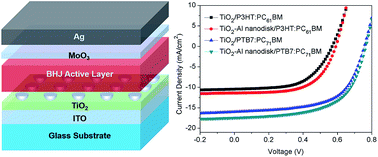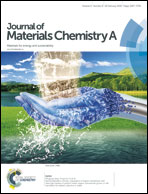Fabrication of tunable aluminum nanodisk arrays via a self-assembly nanoparticle template method and their applications for performance enhancement in organic photovoltaics†
Abstract
Aluminum (Al) plasmonic nanostructures have attracted increasing interest for plasmonic applications due to their advantages of supporting tunable surface plasmon resonances over a wide spectral range, from ultraviolet to near infrared spectral regions, as well as their earth-abundance and thus low cost when compared to the noble metals. Nevertheless, developing a reliable fabrication method that enables the formation of Al nanostructures with designed dispersity, controllable size and large-scale production is still challenging. In this work, we report a novel self-assembly nanoparticle template method to achieve well-dispersed and size-tunable Al nanodisk arrays on a titanium dioxide (TiO2) substrate. The Al nanodisk arrays were successfully employed to enhance the performance of bulk heterojunction (BHJ) organic photovoltaics (OPVs) for the first time. Compared to the reference devices, the average power conversion efficiencies (PCEs) of the devices utilizing Al nanodisk arrays are remarkably enhanced from 3.30% to 4.08% for a poly(3-hexylthiophene):[6,6]-phenyl-C61-butyric acid methyl ester (P3HT:PC61BM) blend and from 7.28% to 8.04% for a poly[[4,8-bis[(2-ethylhexyl)oxy]benzo[1,2-b:4,5-b′]dithiophene-2,6-diyl][3-fluoro-2-[(2-ethylhexyl)carbonyl]thieno[3,4-b]thiophenediyl]]:phenyl-C71-butyric acid methyl ester (PTB7:PC71BM) blend. The champion devices show PCEs of 4.32% and 8.48% for P3HT:PC61BM and PTB7:PC71BM active layers, respectively. According to the optical and electrical characterization of both the reference and Al nanodisk array-enhanced devices, the improvement in device performance was attributed to the enhancement in the light absorption of the active layer and the better energy level alignment caused by the Al nanodisk arrays. This study clearly demonstrates the promise of an Al nanoparticle array as a plasmonic nanostructure for photovoltaic performance enhancement in OPVs, and it could be easily extended to other types of photovoltaic devices and many mainstream plasmon-enabled or enhanced applications.



 Please wait while we load your content...
Please wait while we load your content...